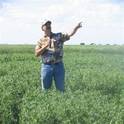
Presentation
Measured and Predicted Temporal Changes in Soil Nitrate-N Levels from Late Summer to early Spring in Montana
Western Nutrition Management Conference
(2011)
Abstract
Most soil sampling is conducted from August to November in Montana because of better soil sampling conditions and because it provides more time for growers to make fertilizer decisions prior to application. Fertilizer guidelines in Montana are based on spring nitrate-N levels in the upper 2 ft because they are more indicative of growing season available N than fall nitrate-N levels. It is not known how much nitrate-N levels change between late summer and spring, nor is it known what factors affect these changes, and large changes could result in either over-application of N fertilizer or sub-optimal yields. A three-year study was initiated in August 2007 at eight locations in Montana to determine differences in nitrate-N levels for late summer, late fall and early spring sampling. A primary goal of the study was to model nitrate-N changes based on previous crop, soil characteristics, and weather conditions to enable producers to adjust their N rates based on fall soil sampling. Soil samples (0 to 6; 6 to 24 inches unless rocks prevented coring) were collected in late August/early September and mid- November following four previous crop types (annual legume, fallow, oilseed, and small grain), and the sampling was repeated within 1 foot of the initial sampling points in early April of the subsequent year. Soil samples were analyzed for parameters that would typically be included in a soil test (producer model) and/or might influence temporal nitrate changes such as soil texture and soil water content (full model). Additive mixed models were used to predict changes in nitrate-N levels (in lb/ac) using these soil parameters, previous crop, precipitation amounts and average air temperatures as fixed effects. Random effects for both study location and year were used to account for systematic differences among locations and years. When averaged over previous crop, locations and years, nitrate-N levels increased by 18 lb ± 21 N/ac from late summer to early spring and by 5 lb ± 28 lb N/ac from late fall to early spring. These standard deviations demonstrate that nitrate changes in individual site-years can be much different than averages, and could result in substantial under or over fertilization if late summer or late fall soil samples were only adjusted with average differences. The predictive models indicated that initial nitrate and soil depth were the most important fixed effects at influencing overwinter nitrate changes, yet most of the variability in nitrate changes was not explained by the models.
Keywords
- soil sampling,
- fertilizer,
- nitrate-N
Disciplines
Publication Date
2011
Location
Reno, NV, United States
Comments
Works produced by employees of the U.S. Government as part of their official duties are not copyrighted within the U.S. The content of this document is not copyrighted.
Citation Information
Andrew W. Lenssen, Clain Jones, Chengci Chen, Kent McVay, et al.. "Measured and Predicted Temporal Changes in Soil Nitrate-N Levels from Late Summer to early Spring in Montana" Western Nutrition Management Conference (2011) Available at: http://works.bepress.com/andrew_lenssen/80/
